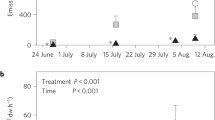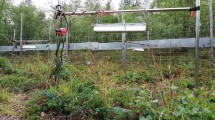Abstract
Boreal and subarctic peatlands have been extensively studied for their major role in the global carbon balance. However, study efforts have so far neglected the contribution of these ecosystems to the non-methane biogenic volatile organic compound (BVOC) emissions, which are important in the atmospheric chemistry and feedbacks on climate change. We aimed at estimating the BVOC emissions from a subarctic peatland in northern Finland. Furthermore, our aim was to assess how these emissions are affected by enhanced UV-B radiation, the amount of which has increased especially at high latitudes as a result of stratospheric ozone depletion. The contribution of BVOC emissions to the total net carbon exchange and correlations between the emission of different BVOCs and net ecosystem CO2 exchange, CH4 emission, total green leaf area, and abiotic factors were also studied. The UV-B exposure, simulating a 20% depletion of stratospheric ozone, was started in 2003, and measurements were performed during the growing seasons of 2006 and 2008. The subarctic peatland proved to be a small source of BVOCs and the dominant moss, Warnstorfia exannulata, emitted a diverse compound spectrum. The water table level exerted a major influence on the BVOC emissions surpassing the effect of enhanced UV-B. In fact, no overall UV-B effect was established on the BVOC emissions, apart from toluene and 1-octene, emissions of which were doubled and tripled by enhanced UV-B in 2008, respectively. The contribution of BVOCs to the total net carbon exchange was below 1%.







Similar content being viewed by others
References
ACIA. 2005. Arctic climate impact assessment. New York (NY): Cambridge University Press.
Alm J, Talanov A, Saarnio S, Silvola J, Ikkonen E, Aaltonen H, Nykänen H, Martikainen PJ. 1997. Reconstruction of the carbon balance for microsites in a boreal oligotrophic pine fen, Finland. Oecologia 110:423–31.
Bäckstrand K, Crill PM, Mastepanov M, Christensen TR, Bastviken D. 2008. Non-methane volatile organic compound flux from a subarctic mire in Northern Sweden. Tellus B 60:226–37.
Beckmann M, Lloyd D. 2001. Extraction and identification of volatile organic substances (VOS) from Scottish peat cores. Atmospheric Environ 35:79–86.
Blande JD, Turunen K, Holopainen JK. 2009. Pine weevil feeding on Norway spruce bark has a stronger impact on needle VOC emissions than enhanced ultraviolet-B radiation. Environ Pollut 157:174–80.
Callaghan TV, Björn LO, Chernov Y, Chapin T, Christensen TR, Huntley B, Ims RA, Johansson M, Jolly D, Jonasson S, Matveyeva N, Panikov N, Oechel W, Shaver G, Elster J, Jónsdóttir IS, Laine K, Taulavuori K, Taulavuori E, Zöckler C. 2004. Responses to projected changes in climate and UV-B at the species level. Ambio 33:418–35.
Dormann CF, Woodin SJ. 2002. Climate change in the Arctic: using plant functional types in a meta-analysis of field experiments. Funct Ecol 16:4–17.
Ekberg A, Arneth A, Hakola H, Hayward S, Holst T. 2009. Isoprene emission from wetland sedges. Biogeosciences 6:601–13.
Faubert P, Tiiva P, Rinnan Å, Michelsen A, Holopainen JK, Rinnan R. 2010. Doubled volatile organic compound emissions from subarctic tundra under simulated climate warming. New Phytol 187:199–208.
Gorham E. 1991. Northern peatlands: role in the carbon cycle and probable responses to climatic warming. Ecol Appl 1:182–95.
Guenther A, Hewitt CN, Erickson D, Fall R, Geron C, Graedel T, Harley P, Klinger L, Lerdau M, McKay WA, Pierce T, Scholes B, Steinbrecher R, Tallamraju R, Taylor J, Zimmerman P. 1995. A global model of natural volatile organic compound emissions. J Geophys Res 100:8873–92.
Haapala JK, Mörsky SK, Saarnio S, Rinnan R, Suokanerva H, Kyrö E, Latola K, Martikainen PJ, Holopainen T, Silvola J. 2009. Carbon dioxide balance of a fen ecosystem in northern Finland under elevated UV-B radiation. Glob Change Biol 15:943–54.
Haapanala S, Rinne J, Pystynen K-H, Hellén H, Hakola H, Riutta T. 2006. Measurements of hydrocarbon emissions from a boreal fen using the REA technique. Biogeosciences 3:103–12.
Harley P, Deem G, Flint S, Caldwell M. 1996. Effects of growth under elevated UV-B on photosynthesis and isoprene emission in Quercus gambelii and Mucuna pruriens. Glob Change Biol 2:149–54.
Hellén H, Hakola H, Pystynen K-H, Rinne J, Haapanala S. 2006. C2-C10 hydrocarbon emissions from a boreal wetland and forest floor. Biogeosciences 3:167–74.
Helmig D, Klinger LF, Guenther A, Vierling L, Geron C, Zimmerman P. 1999. Biogenic volatile organic compound emissions (BVOCs) I. Identifications from three continental sites in the U.S. Chemosphere 38:2163–87.
IPCC. 2007. Climate change 2007: the physical science basis. In: Solomon S, Qin D, Manning M, Chen Z, Marquis M, Averyt KB, Tignor M, Miller HL, Eds. Contribution of working group I to the fourth assessment report of the Intergovernmental Panel on Climate Change. Cambridge, United Kingdom and New York (NY): Cambridge University Press.
Janson R, De Serves C, Romero R. 1999. Emission of isoprene and carbonyl compounds from a boreal forest and wetland in Sweden. Agric For Meteorol 98–99:671–81.
Klinger LF, Zimmerman PR, Greenberg JP, Heidt LE, Guenther AB. 1994. Carbon trace gas fluxes along a successional gradient in the Hudson Bay lowland. J Geophys Res 99:1469–94.
Laothawornkitkul J, Taylor JE, Paul ND, Hewitt CN. 2009. Biogenic volatile organic compounds in the Earth system. New Phytol 183:27–51.
Lee JH, Batterman SA, Jia C, Chernyak S. 2006. Ozne artifacts and carbonyl measurements using Tenax GR, Tenax TA, Carbopack B, and Carbopack X adsorbents. J Air Waste Manag Assoc 56:1503–17.
Leff JW, Fierer N. 2008. Volatile organic compound (VOC) emissions from soil and litter samples. Soil Biol Biochem 40:1629–36.
Newsham KK, Robinson SA. 2009. Responses of plants in polar regions to UVB exposure: a meta-analysis. Glob Change Biol 15:2574–89.
Newsham KK, McLeod AR, Greenslade PD, Emmett BA. 1996. Appropriate controls in outdoor UV-B supplementation experiments. Glob Change Biol 2:319–24.
Niemi R, Martikainen PJ, Silvola J, Sonninen E, Wulff A, Holopainen T. 2002. Responses of two Sphagnum moss species and Eriophorum vaginatum to enhanced UV-B in a summer of low UV intensity. New Phytol 156:509–15.
Ortega J, Helmig D. 2008. Approaches for quantifying reactive and low-volatility biogenic organic compound emissions by vegetation enclosure techniques–Part A. Chemosphere 72:343–64.
Rasmussen S, Wolff C, Rudolph H. 1995. Compartmentalization of phenolic constituents in Sphagnum. Phytochemistry 38:35–9.
Rinnan R, Rinnan Å, Holopainen T, Holopainen JK, Pasanen P. 2005. Emission of non-methane volatile organic compounds (VOCs) from boreal peatland microcosms—effects of ozone exposure. Atmospheric Environ 39:921–30.
Rinnan R, Nerg A-M, Ahtoniemi P, Suokanerva H, Holopainen T, Kyrö E, Bååth E. 2008. Plant-mediated effects of elevated ultraviolet-B radiation on peat microbial communities of a subarctic mire. Glob Change Biol 14:925–37.
Rinne J, Tuovinen J-P, Laurila T, Hakola H, Aurela M, Hypén H. 2000. Measurements of hydrocarbon fluxes by a gradient method above a northern boreal forest. Agric For Meteorol 102:25–37.
Scharf B. 2006. Long term effects of ozone depletion on anatomy and physiology of Eriophorum russeolum Fries ex Hartm. A field experiment in Finnish Lapland. Diploma Thesis, Department of Systematic Botany, University of Osnabrück, Osnabrück, Germany.
Tholl D, Boland W, Hansel A, Loreto F, Röse USR, Schnitzler J-P. 2006. Practical approaches to plant volatile analysis. Plant J 45:540–60.
Tiiva P, Rinnan R, Faubert P, Räsänen J, Holopainen T, Kyrö E, Holopainen JK. 2007a. Isoprene emission from a subarctic peatland under enhanced UV-B radiation. New Phytol 176:346–55.
Tiiva P, Rinnan R, Holopainen T, Mörsky SK, Holopainen JK. 2007b. Isoprene emissions from boreal peatland microcosms; effects of elevated ozone concentration in an open field experiment. Atmospheric Environ 41:3819–28.
Tiiva P, Faubert P, Räty S, Holopainen JK, Holopainen T, Rinnan R. 2009. Contribution of vegetation and water table on isoprene emission from boreal peatland microcosms. Atmospheric Environ 43:5469–75.
Turunen J, Tomppo E, Tolonen K, Reinikainen A. 2002. Estimating carbon accumulation rates of undrained mires in Finland—application to boreal and subarctic regions. Holocene 12:69–80.
Vuorinen T, Nerg A-M, Ibrahim MA, Reddy GVP, Holopainen JK. 2004. Emission of Plutella xylostella-induced compounds from cabbages grown at elevated CO2 and orientation behavior of the natural enemies. Plant Physiol 135:1984–92.
Wilson D, Alm J, Riutta T, Laine J, Byrne KA, Farrell EP, Tuittila E-S. 2007. A high resolution green area index for modelling the seasonal dynamics of CO2 exchange in peatland vascular plant communities. Plant Ecol 190:37–51.
WMO (World Meteorological Organization). 2007. Scientific assessment of ozone depletion: 2006, Global Ozone Research and Monitoring Project—Report No. 50, 572 p. Geneva, Switzerland.
Acknowledgements
We thank Timo Oksanen for constructing the equipment, Juhani Tarhanen for assistance in the GC–MS analyses, Hanne Suokanerva for the maintenance of the field experiment, and Mia Åberg and Santtu Turunen for the data collection in the field. We are also thankful to Professors Roger Atkinson and Magda Claeys for their valuable contribution to the compound classification. The study was financially supported by Emil Aaltonen Foundation and Academy of Finland (decisions 202300 and 200884), and the research fellowships awarded to Patrick Faubert by FQRNT, North Savo Regional Fund of the Finnish Cultural Foundation and Ella and Georg Ehrnrooth Foundation.
Author information
Authors and Affiliations
Corresponding author
Additional information
Author contributions
P. F. contributed to the field work, data analysis and wrote the paper. P. T. contributed to the field work, data analysis and writing. Å. R. contributed to the methods in the data analysis and writing. J. R. contributed to the field work and data analysis. J. K. H., T. H. and E.K. conceived and designed the study and contributed to the writing. R. R. conceived and designed the study, contributed to the field work, data analysis and writing.
Rights and permissions
About this article
Cite this article
Faubert, P., Tiiva, P., Rinnan, Å. et al. Non-Methane Biogenic Volatile Organic Compound Emissions from a Subarctic Peatland Under Enhanced UV-B Radiation. Ecosystems 13, 860–873 (2010). https://doi.org/10.1007/s10021-010-9362-1
Received:
Accepted:
Published:
Issue Date:
DOI: https://doi.org/10.1007/s10021-010-9362-1




